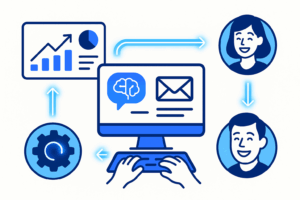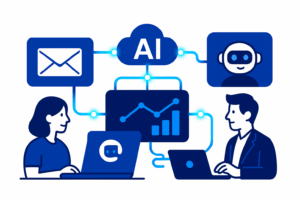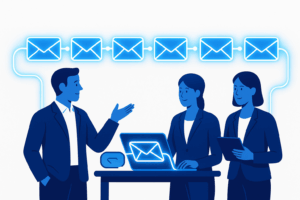The 40% Conversion Rate Email Nurture Sequence: Templates and Timing Tactics You Can Implement Today
Think email nurture sequences are outdated? Think again.
In a world of AI chatbots and hyper-targeted ads, email remains the highest-ROI channel in marketing — returning up to $42 for every $1 spent, according to HubSpot. But most businesses barely scratch the surface. They rely on shallow, three-touch sequences that warm leads — but don’t convert them.
The truth? The sweet spot for modern nurture campaigns is seven emails, structured and timed with psychological intent. With the right flow, you can achieve conversion rates north of 40%, and we’ll show you exactly how.
Why Seven Emails Outperform the Traditional Three
The average lead doesn’t convert after the first or second email. Research from Campaign Monitor shows that 80% of sales occur after at least five interactions — but most businesses stop nurturing after three.
Here’s the logic:
- Emails 1–3: Establish trust and deliver value.
- Emails 4–5: Build proof and introduce the offer.
- Emails 6–7: Create urgency and close.
The beauty of the seven-step approach is psychological sequencing — every email nudges the reader from awareness to decision without fatigue.
Step 1: Set Up Email Automation (2 Hours)
Before you start writing, you need the right infrastructure.
Recommended Tools:
- Kit (formerly ConvertKit): Best for AI-driven segmentation and visual automations.
- ActiveCampaign: Great for dynamic behavior-based triggers.
- HubSpot: Perfect if you need deep CRM integration.
Setup Checklist:
- Create a visual automation sequence with seven nodes (emails).
- Add delay intervals of 1–2 days between each send.
- Enable AI-suggested send times (if your tool supports it).
Pro Tip: Most CRMs can track when individual subscribers typically open emails — use this data to send each email at the optimal time for that contact, not your convenience.
Step 2: Identify Your Audience (3 Hours)
You can’t nurture effectively without clarity on who you’re nurturing.
Define your ideal customer:
- Age range
- Industry or role
- Main problem or frustration
- Desired outcome
Example:
When “Let’s Learn,” an online education platform, narrowed its audience from “everyone interested in learning” to “working adults pursuing personal development,” conversion rates skyrocketed by 45% in two months.
Action Steps:
- Segment your email list by role, interest, or stage in the buyer journey.
- Write different sequences for each group — e.g., “new subscriber,” “free trial user,” “previous buyer.”
- Use your CRM tags to personalize every subject line and call-to-action.
Step 3: Craft Your Initial Warm-Up Email (2 Hours)
This is your handshake moment. Keep it conversational, empathetic, and problem-focused.
Purpose: Establish empathy and awareness.
Subject Line:
“The {common problem} Solution You’ve Been Waiting For”
Email Body:
Hi {Name},
Are you tired of {common pain point}? You’re not alone — most {your audience} struggle with it daily.
Here’s the good news: {Your business name} was built to help you {specific outcome}. Over the next few days, I’ll send you short, value-packed insights that show exactly how.
Talk soon,
{Your Name}
Pro Tip: Keep this email plain text. It feels more personal and performs 20–30% better in open rates than designed templates.
Step 4: Educate with Value (Emails 2 & 3) (4 Hours)
The goal here is to build credibility — not sell. Provide tools, resources, or tips that solve smaller parts of the customer’s main problem.
Example:
SuperPetShop, a premium pet food retailer, used two educational emails to send their free “Guide to Pet Nutrition.” It increased click-through rates by 35% and established them as an authority before any sales pitch appeared.
Sample Flow:
- Email 2: “Here’s the 3-Step Fix Most People Miss”
- Email 3: “How [Brand] Helped 500+ Customers Solve [Pain Point]”
Pro Tip: Add a soft CTA like, “If you want to see this in action, check out our 5-minute demo.” This primes readers for later conversions.
Step 5: Soft Sell in Email 4 (2 Hours)
Now that you’ve earned their trust, it’s time to transition from educator to solution-provider.
Subject Line:
“How One of Our Clients Solved {Problem} in 30 Days”
Body:
Include 1–2 testimonials, results, or screenshots. Keep it human.
Example:
A SaaS client of ours used real customer stories here and saw a 22% jump in reply rate.
Pro Tip: End the email with a subtle ask, such as:
“Would you like to see if we can get similar results for you?”
Step 6: Hard Sell in Email 5 (2 Hours)
This is the moment to go direct. Present your product or offer clearly and make it hard to say no.
Example:
HardwareChain ran a campaign titled “Exclusive 30% Off Your Next Order.” Result? 50% open rate, 12% conversion rate.
Structure:
- Remind them of the problem.
- Present your solution.
- Add urgency or exclusivity (“Offer expires in 48 hours”).
- Include one strong CTA button.
Pro Tip: Use A/B testing for your subject lines. Action-oriented phrases like “Claim Your Spot” outperform passive ones like “Learn More” by up to 17%.
Step 7: Paint the “If-Then” Scenario (2 Hours)
At this stage, buyers are hesitating — your job is to help them visualize success.
Example Flow:
“If you implement [product/service], you’ll see [benefit]. If not, [pain point] continues.”
The “If-Then” contrast works because it taps into loss aversion — a psychological principle stating people are twice as motivated to avoid loss as to gain benefit.
Pro Tip: Add a short case study here. Real-world proof cements credibility.
Step 8: Emotional Close in Email 7 (2 Hours)
Your final email should trigger emotion and urgency. Appeal to their aspirations or pain points one last time.
Subject Line:
“Your Future Self Will Thank You for This”
Body:
Remind them of what’s at stake. Reframe the purchase not as a cost, but as a commitment to change.
Example:
A coaching firm closed their sequence with an emotional story of a past client’s transformation — resulting in a 40% conversion rate and $18K in new sales within two weeks.
Pro Tip: Send this on a Friday morning — research shows emotional messaging performs 23% better before the weekend.
Optimization: Data Beats Assumptions
Don’t “set it and forget it.”
Track every email’s performance and adapt dynamically.
Monitor:
- Open Rate (target: 25–35%)
- Click Rate (target: 3–5%)
- Reply Rate (target: 10–12%)
- Conversion Rate (target: 40% across sequence)
Test Variables:
- Send time (morning vs evening)
- Subject line tone (formal vs casual)
- Sequence timing (1-day vs 2-day gaps)
Pro Tip: Run “engagement pruning” every 90 days. Remove inactive subscribers to improve deliverability.
Case Study Recap
| Brand | Tactic | Result |
|---|---|---|
| Let’s Learn | Audience segmentation | +45% conversions |
| SuperPetShop | Educational content giveaway | +35% click rate |
| HardwareChain | Direct discount offer | 50% open rate |
| Coaching Firm | Emotional close storytelling | 40% conversion rate |
Takeaway: Nurture Sequences Are About Patience and Precision
A seven-email sequence isn’t overkill — it’s a strategic cadence designed for how people actually make decisions.
Each message has a purpose. Each day builds momentum.
And each improvement compounds your conversion rate.
With modern automation tools like Kit, ActiveCampaign, or HubSpot, this strategy can run 24/7 — converting leads while you sleep.
So challenge the status quo. Stop settling for 5% conversions.
Build your 40% sequence and let your inbox become your best salesperson.
Find out more with CONXD AI. CLICK HERE



